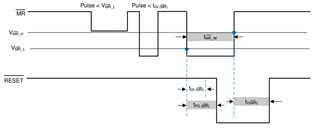Hello, I'm struggeling a bit with the parameters sense glitch immunity (tGI) and detect propagation delay (tPD). How are both related to each other? If we consider e.g. an undervoltage / overvoltage condition for 100us and measure the time from start of out of range condition (UV / OV) until the RESET output is going to Low level then we have measured the parameter tPD. If the pulse would be shorter than the measured time then the output would not switch to Low level. In this case we would have determined the glitch immunity, wouldn't we? If my assumption is wrong what would be the correct way to evaluate the glitch immunity via test?
Many thanks in advance!
Best regards,
Andreas N.



